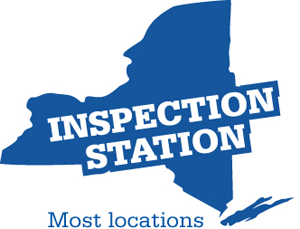NY State Motor Vehicle Inspections
Inspection extensions
You can receive an inspection extension if you buy or get a vehicle from an out-of-state source. After you register the vehicle in NYS, you are allowed ten days to complete the vehicle inspection. Any inspection issued to the previous registrant is not valid after you register the vehicle.
If you become a New York state resident
If you become a resident of NYS and register your vehicle in NYS, your out-of-state inspection remains valid. The out-of-state certificate or inspection sticker issued in your name is valid until it expires, or for one year after the vehicle is registered in NYS, whichever comes first. When your out-of-state inspection expires, you must get the vehicle inspected in NYS.
What items does NY State Require be checked for the Safety Inspection?
- Seat Belts
- Brakes
- Steering, Front End, Suspension, Chassis, Frame and Wheel Fasteners
- Tires (Except spare)
- Lights
- Windshield and Other Glass
- Windshield Wipers and Blades
- Horn
- Mirrors
- Fuel Leaks
- Tinted Windows (effective Jan.17)
See full details of the requirements here.
What are the Emissions Inspection requirements?
(Excerpt taken directly from NY State DMV Website)
The 1990 Federal Clean Air Act requires New York State to conduct an inspection program to help reduce harmful emissions from most passenger cars and light-duty trucks. The emissions inspection is done at the same time as the annual safety inspection. Vehicles that fail the emissions inspection may not be able to become registered or, if already registered, the registration may not be renewed.
On-Board Diagnostics Generation II (OBDII) Inspection. Most 1996 or newer gasoline-powered vehicles and most 1997 or newer diesel-powered vehicles that have a gross vehicle weight rating (GVWR) less than 8,501 pounds are subject to the OBDII emissions inspection. This test examines the Malfunction Indicator Lamp (MIL), also known as the "check engine" light, for operation/illumination, and verifies the test results of the vehicle's "on-board emissions diagnostic" system.
Low Enhanced Inspection. A "Low Enhanced" emissions inspection is required for most other vehicles, unless they are subject to the OBDII test or are exempt from all emissions inspections. This inspection is required for all vehicles from and including model year 1995 and older, through and including vehicles that are up to 25 model years old, and that weigh 18,000 lbs. or less.
Each emissions inspection for gasoline-powered vehicles confirms the presence and connection of the vehicle's required emissions control devices. This includes making sure that the vehicle's gas cap is present, is in good condition, and fits properly.
The following emissions control devices are examined if the vehicle was originally manufactured with them:
- Catalytic converter (CAT)
- Exhaust gas recirculation valve (EGR)
- Positive crankcase ventilation system (PCV)
- Air injection system (AIS)
- Evaporative emissions control (EVAP)
- Fuel inlet restrictor (FIR)
- Thermostatic air cleaner (TAC)
You can help your vehicle pass an OBDII emissions inspection by keeping it properly maintained. If the vehicle's Malfunction Indicator Lamp (MIL, or "check engine" light) indicates there may be a malfunction or other problem, have the vehicle properly repaired. A well maintained, properly functioning vehicle uses less fuel and creates less exhaust emissions.
Service Available at
- Buffalo, New York
- Blasdell
- Buffalo
- Lancaster
- Niagara Falls
- Clarence/Williamsville
- Amherst
- West Seneca
- Lockport
- Erie, Pennsylvania
- Erie (Peach St)
- Erie (West 12th St)
- Harborcreek
- Rochester, New York
- Batavia
- Brockport
- Greece
- Pittsford
- Gates
- Webster
- Henrietta
- Southern Tier, New York
- Jamestown
- Dunkirk/Fredonia
- Olean
- Syracuse, New York
- Mattydale
- Dewitt
- Camillus
- Auburn

Dunn Tire is an official New York state vehicle inspection station.
All vehicles registered in New York State must get a safety inspection and an emissions inspection every 12 months. See the NY State Inspection Requirements here. Both inspections are also required when the ownership of a vehicle is transferred. (Some vehicles are exempt from emissions inspections.)
